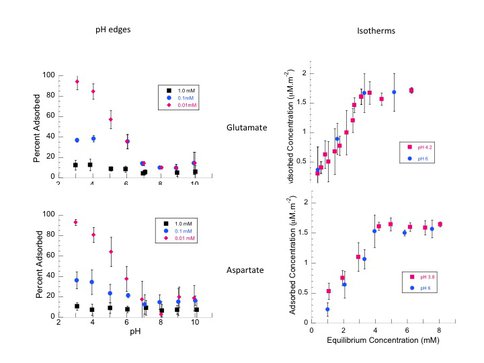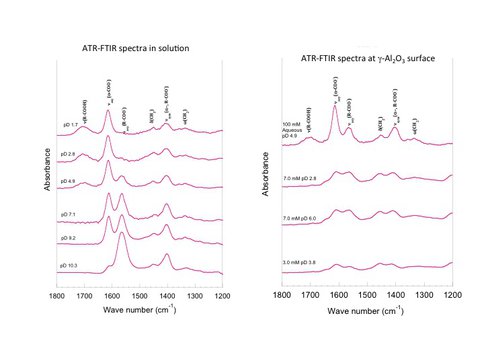2012 Annual Science Report
 University of Wisconsin
Reporting | SEP 2011 – AUG 2012
University of Wisconsin
Reporting | SEP 2011 – AUG 2012
Project 1C: Absorption of Amino Acids on Minerals
Project Summary
The role of mineral surfaces in extraterrestrial organic synthesis, pre-biotic chemistry, and the early evolution of life remains an open question. Mineral surfaces could promote synthesis, preservation, or degradation of chiral excesses of organic small molecules, polymers, and cells. Different minerals, crystal faces of a mineral, or defects on a face may selectively interact with specific organics, providing an enormous range of chemical possibilities. It has also been suggested in the literature that amino acids may have been delivered to early Earth by meteorite impacts. We focused here on amino-acid adsorption and conformation on model mineral, γ-Al2O3.
We measured adsorption of the acidic amino-acids, glutamate and aspartate, on model nanparticulate oxide mineral, γ-Al2O3. Our results should help provide an estimate of the amount of amino-acids delivered. Using bulk adsorption isotherms our results showed similar amounts of adsorption of both amino-acids and FTIR spectroscopy revealed similar bonding configurations for the adsorbed species, over a range of pHs and concentrations.
The project addresses NASA Astrobiology Institute’s (NAI) Roadmap Goal 3 of understanding how life emerges from cosmic and planetary precursors, and Goal 4 of understanding organic and biosignature preservation mechanisms. The work is relevant to NASA’s Strategic Goal of advancing scientific knowledge on the origin and evolution life on Earth and potentially elsewhere, and of planning future Missions by helping to identify promising targets for the discovery of organics.
Project Progress
Between 4.8 and 3.8 Ga, the earth experienced periods of bombardments of meterioritic material including as carbonaceous chondrites. These meteorites contained organic compounds such as amino acids (AA), and are composed of 2 – 3% Al2O3. The Al2O3surface contains >AlO- binding sites for adsorption of AAS. The γ-Al2O3 phase has a high surface area, 26.6 m2/g and is a good starting point to establish techniques for studying amino-acid adsorption onto meteorites.
We have measured bulk adsorption data (pH-edges and adsorption isotherms) which show that the maximum adsorption density of both Glu and Asp on γ-Al2O3 is 1.6 μM / m2 (Figure 1). We used ATR-FTIR to determining the binding coordination (Figure 2). We used these binding modes to determine the stoichiometry of adsorption reactions (number of Glu or Asp molecules adsorbed per surface site). Both Glu and Asp were found to adsorb similarly in the following geometries depending on pH: bridging bidentate via both carboxylate groups at acidic pH, H-bonded via one or two carboxylate groups at mid-pH range, and monodentate, electrostatic binding via the amine group above the PZC of alumina (pH > 9).
Adsorption of L-Glutamate and L-Aspartate on g-Al2O3. pH edges obtained at various ionic strengths of NaCl solutions and isotherms obtained at various pHs.
ATR-FTIR spectra of L-Glutamate in solution at various solution conditions (left) and adsorbed on g-Al2O3 at various conditions (right). Similar spectra are obtained for L-Aspartate.
Publications
-
James Cleaves II, H., Michalkova Scott, A., Hill, F. C., Leszczynski, J., Sahai, N., & Hazen, R. (2012). Mineral–organic interfacial processes: potential roles in the origins of life. Chem. Soc. Rev., 41(16), 5502. doi:10.1039/c2cs35112a
- Greiner, E., Kumar, K., Giuffre, A., Sumit, M., Pedersen, J., Cleaves, J., Dworkin, J. & Sahai, N. (2012). Adsorption of L-Glutamate and L-Aspartate from solution onto γ-Al2O3 surfaces. Langmuir.
-
PROJECT INVESTIGATORS:
-
PROJECT MEMBERS:
Edward Greiner
Graduate Student
-
RELATED OBJECTIVES:
Objective 3.1
Sources of prebiotic materials and catalysts
Objective 3.2
Origins and evolution of functional biomolecules
Objective 4.1
Earth's early biosphere.


